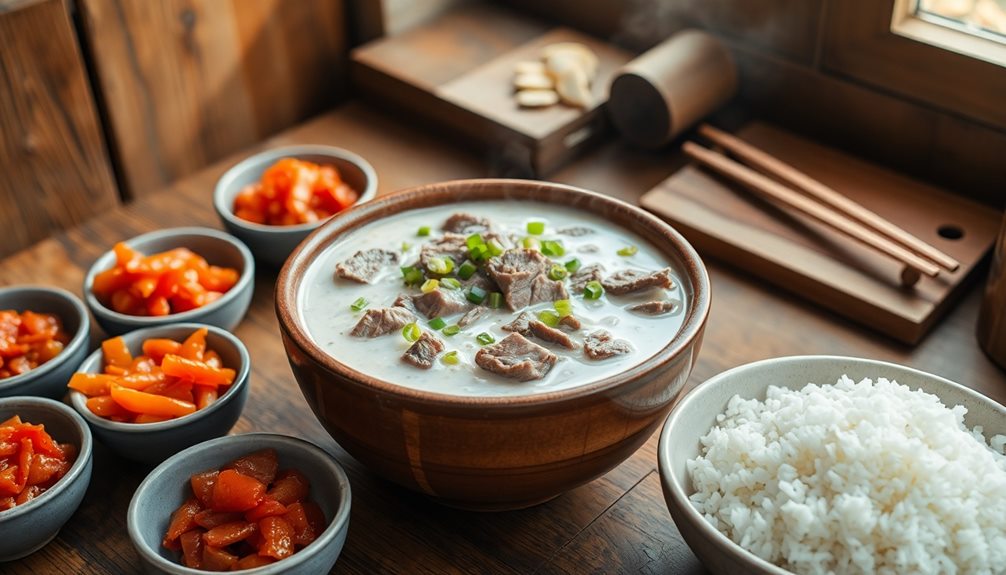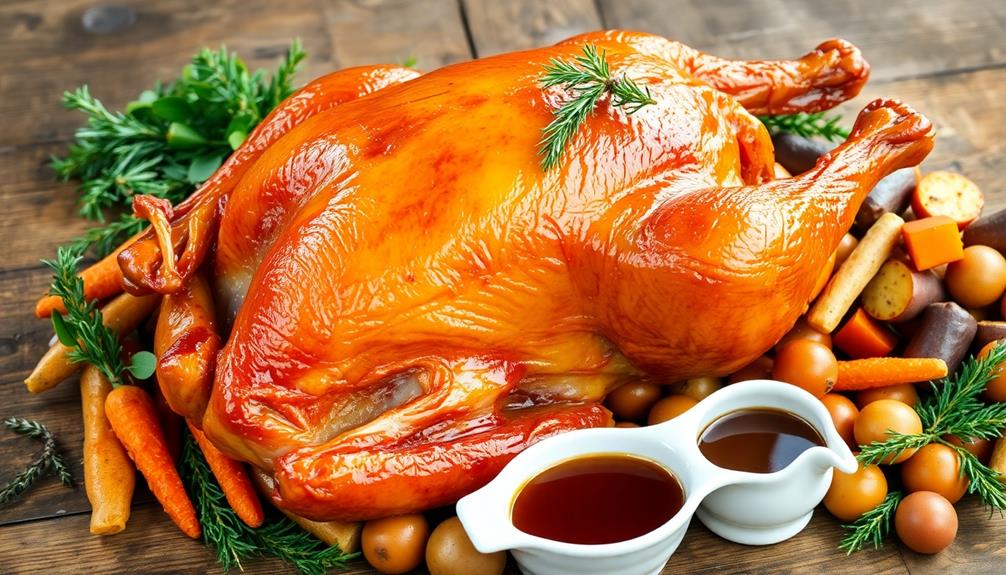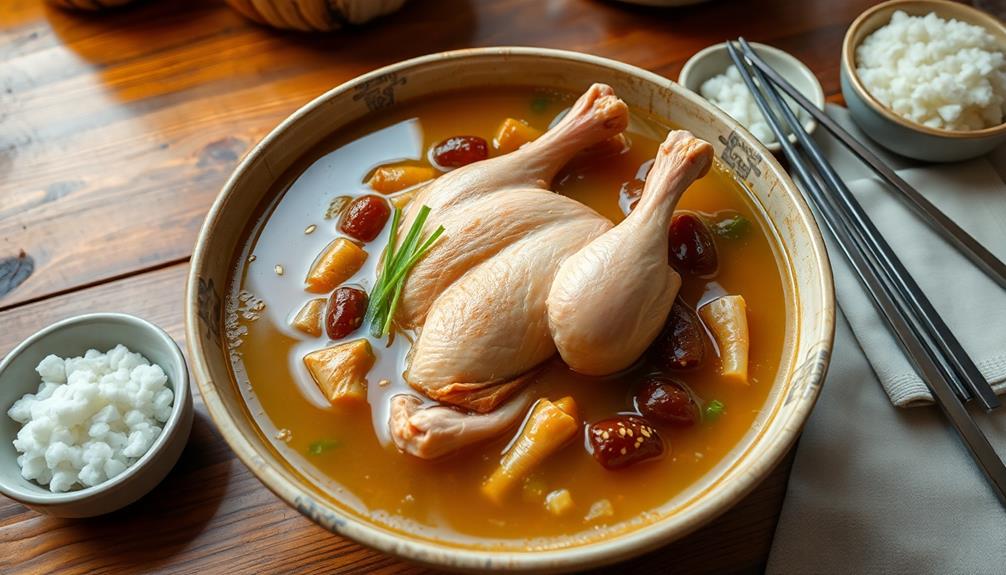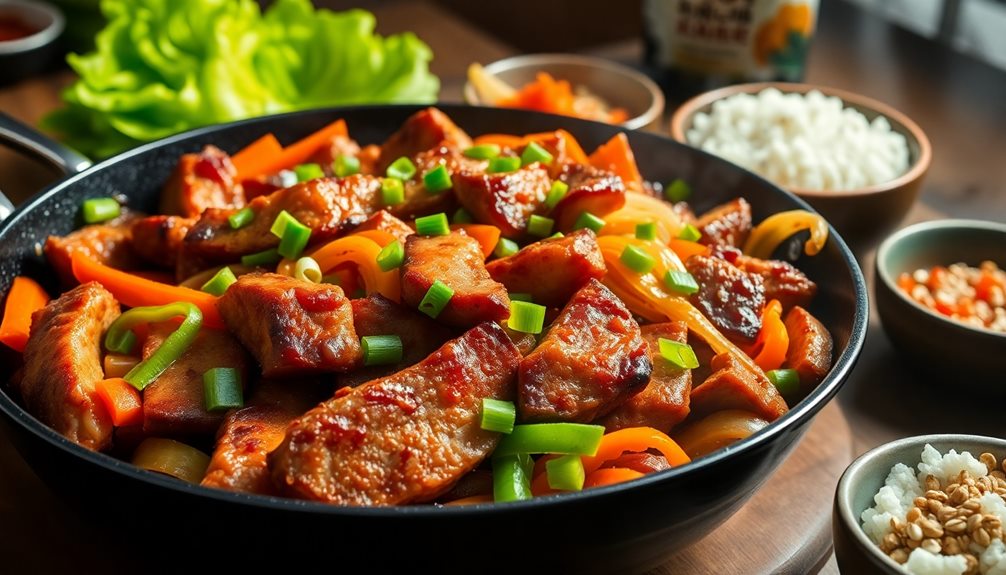Sulung Tang is a delicious Korean ox bone soup that warms your heart and fills your belly! This comforting dish started in the Joseon Dynasty and is made by simmering beef bones for hours, creating a rich and flavorful broth. To make it, you'll soak the bones overnight, then simmer them with garlic, ginger, and other seasonings. It's often served hot, garnished with green onions, and pairs perfectly with rice and kimchi. Families enjoy it together, making it a special and cozy meal. Stick around, and you'll discover more about its history and how to make it yourself!
Key Takeaways
- Sulung Tang is a traditional Korean ox bone soup known for its nourishing qualities, especially during winter months and family gatherings.
- The soup reflects resourcefulness, using all parts of the animal, demonstrating respect for culinary resources in Korean culture.
- Main ingredients include ox bones, beef, garlic, ginger, and seasonings, simmered for hours to create a rich and flavorful broth.
- Nutritionally, Sulung Tang is high in collagen and essential amino acids, promoting joint health and digestive wellness.
- Typically served hot with steamed rice and side dishes, it embodies a communal dining experience, fostering connection among friends and family.
History
Sulung Tang has roots that stretch back centuries in Korean cuisine, often reflecting the resourcefulness of local communities. This delicious soup isn't just food; it's a warm hug on a cold day!
People began making Sulung Tang during the Joseon Dynasty, using ox bones and meat to create a rich, hearty broth. Back then, families would gather around the stove, sharing stories as they waited for the flavors to blend perfectly.
Traditionally, this dish was a way to use every part of the animal, showing respect for the resources they had. Sulung Tang became popular because it was nourishing and helped people feel better, especially during the chilly winter months.
You'll find it served in homes and restaurants alike, and the smell of simmering bones fills the air, inviting you to come closer.
As you enjoy a bowl of Sulung Tang, you're tasting history. Each spoonful connects you to the past, where families worked together to create something special.
Cooking Steps
To create a delicious bowl of Korean ox bone soup, you'll want to start by gathering all your ingredients and tools. Begin by thoroughly rinsing the ox bones to remove any impurities, then boil them to release their rich flavors into the broth. As the soup simmers, it will develop a deep, hearty taste, perfect for pairing with a side of creamy Korean pumpkin soup. Add seasonings like garlic, green onions, and a touch of sesame oil to enhance the flavors just before serving.
You'll need beef bones, water, garlic, ginger, and some green onions. Don't forget your big pot and a strainer! Once you have everything ready, it's time to get cooking.
First, soak the bones in cold water for about an hour. This helps remove any blood and impurities.
After soaking, rinse the bones well and place them in your pot. Add enough water to cover the bones completely. Bring it to a boil, and then reduce the heat to a simmer.
Next, throw in the garlic and ginger to give your soup a wonderful flavor.
Let it simmer for several hours, usually around six, to really extract the goodness from the bones. After that, strain the broth to remove the solids.
Step 1. Gather Fresh Ox Bones
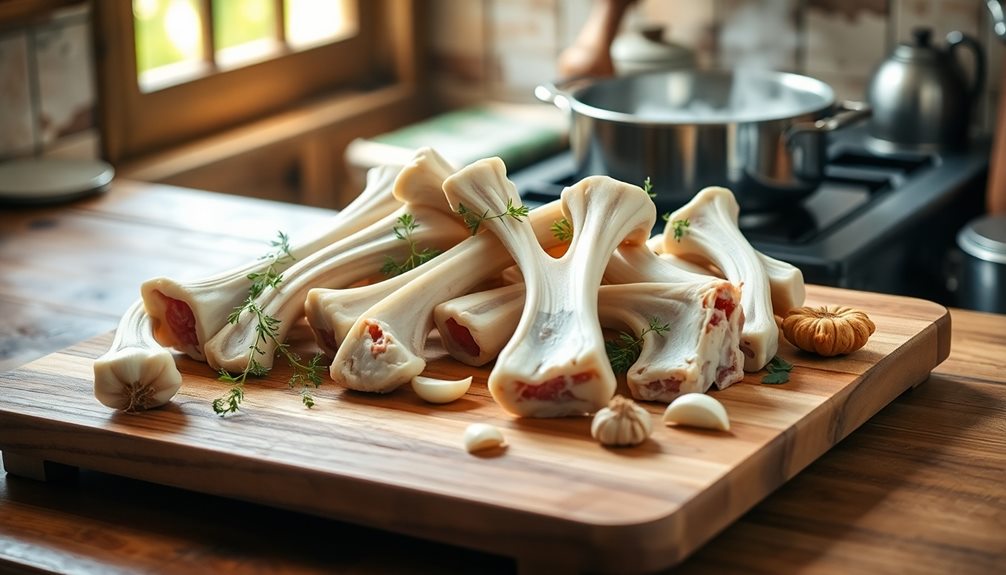
When you're ready to make delicious Sulung Tang, gathering fresh ox bones is crucial for achieving that rich, hearty flavor.
Start by visiting a local butcher or a farmers' market. Look for bones that are fresh and have a good amount of marrow. The marrow adds a wonderful creaminess to the soup, so don't skip it! You can ask the butcher for specific cuts, like knuckle or neck bones, which work great for this dish.
When you choose your bones, make sure they're not discolored or dried out. You want them to look healthy and vibrant. Fresh bones should have a nice, meaty smell, so take a whiff before buying!
It's also helpful to get a mix of bones, as this will deepen the flavor of your soup.
Once you've gathered your bones, try to pick up around two to three pounds. This should be enough to create a nice, hearty soup for you and your family.
With your fresh ox bones in hand, you'll be one step closer to making a warm and comforting bowl of Sulung Tang that everyone will love!
Now, let's move on to the next exciting step!
Step 2. Soak Bones Overnight in Water
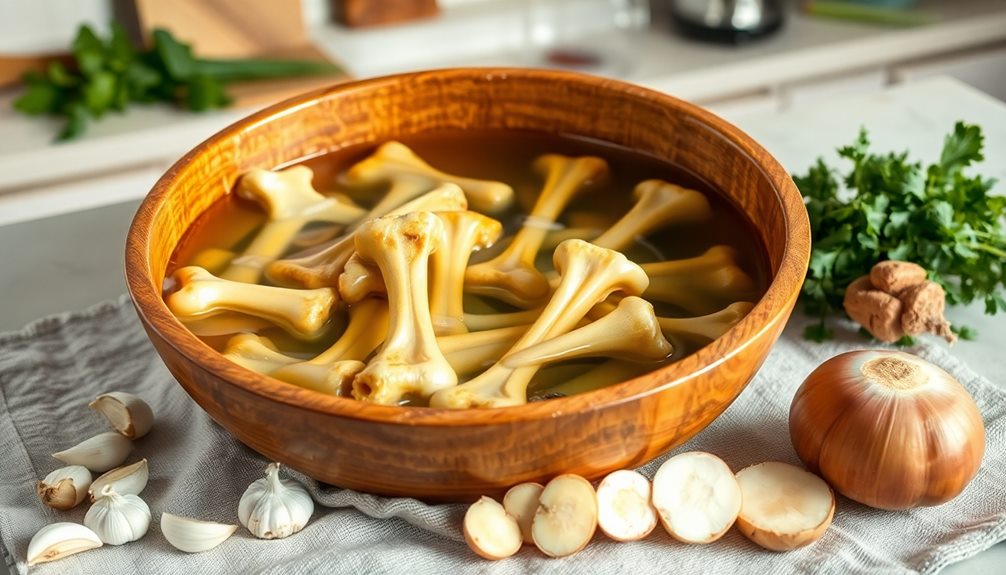
Soaking the bones overnight in water is a crucial step that helps to remove impurities and enhances the soup's flavor. This simple process is key to making your Sulung Tang delicious and comforting.
Start by placing your fresh ox bones in a large bowl or pot. Make sure the bones are completely submerged in water. You can use cold water for this step, as it helps pull out the unwanted bits and dirt.
As the bones soak, you'll notice the water might become a bit cloudy. That's perfectly normal! It means the impurities are being drawn out. Let the bones sit in the water for at least 8 hours, or even overnight if you can. This ensures that they're clean and ready for the next step in your cooking adventure.
Once the soaking time is up, carefully drain the water and rinse the bones under cold running water. This helps wash away any remaining impurities.
Now, you're all set to move on to the next exciting part of making your Sulung Tang. With clean bones, you're one step closer to a warm and hearty meal that's sure to bring comfort to your table!
Step 3. Simmer Bones for Flavor

After rinsing the bones, it's time to bring out their rich flavors by simmering them. Start by placing your cleaned bones in a large pot. Add enough water to cover them completely, then turn up the heat until the water starts to boil.
Once it's boiling, you'll want to reduce the heat to let the bones simmer gently. This slow cooking process is super important because it helps release all those tasty flavors into the water.
Let the bones simmer for at least three to four hours. You might notice some foam or scum rising to the surface. Don't worry; this is normal! Just skim it off with a spoon to keep your broth clear and clean.
As the bones cook, they'll start to give off a wonderful aroma that fills your kitchen with warmth and comfort.
Remember to check the water level occasionally. If it looks low, add a bit more water to keep everything covered.
The longer you let the bones simmer, the richer and deeper the flavor of your sulung tang will be. You're doing great, and soon you'll have a delicious broth ready for the next steps!
Step 4. Strain the Broth Thoroughly
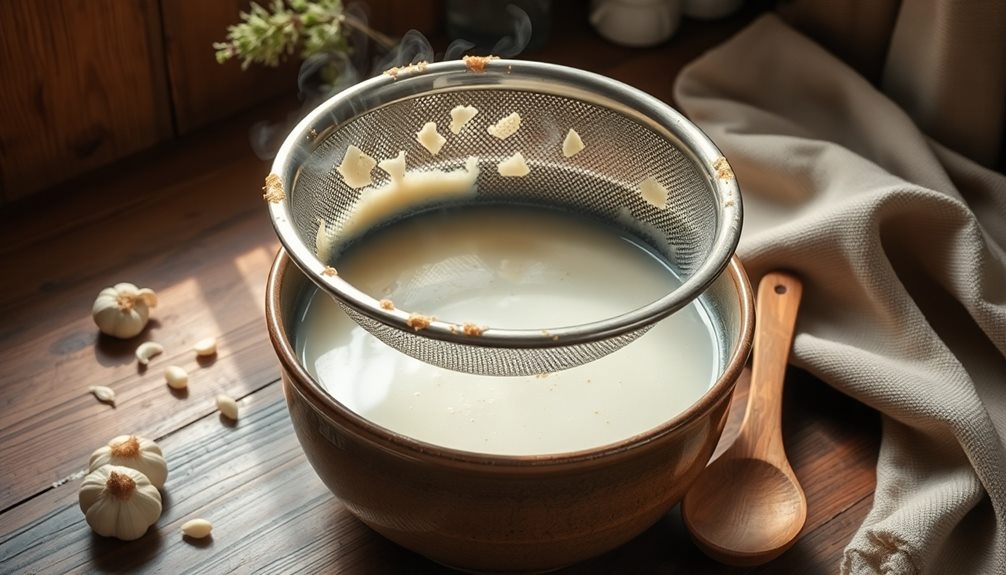
Once your bones have simmered and released their rich flavors, it's time to strain the broth thoroughly. This step is super important because it helps you get a clear and delicious soup!
First, grab a large bowl and a fine mesh strainer or a cheesecloth. You want to make sure all those tasty bits and pieces stay out of your final soup.
Carefully pour your simmered broth through the strainer, letting it catch any leftover bone fragments, fat, or impurities. You might want to use a ladle for this part, as it makes it easier to control the flow.
Watch the steam rise, and enjoy that comforting aroma filling your kitchen!
Once you've strained everything, you can discard the solids left in the strainer. Don't worry; you've captured all the goodness in the liquid.
Now, give the broth a taste. If it's rich and savory, you're on the right track! If it feels a bit bland, don't fret; you'll add more flavor soon.
For now, just relish the fact that you've created a wonderful base for your Sulung Tang, full of warmth and comfort.
Step 5. Add Aromatics and Seasonings
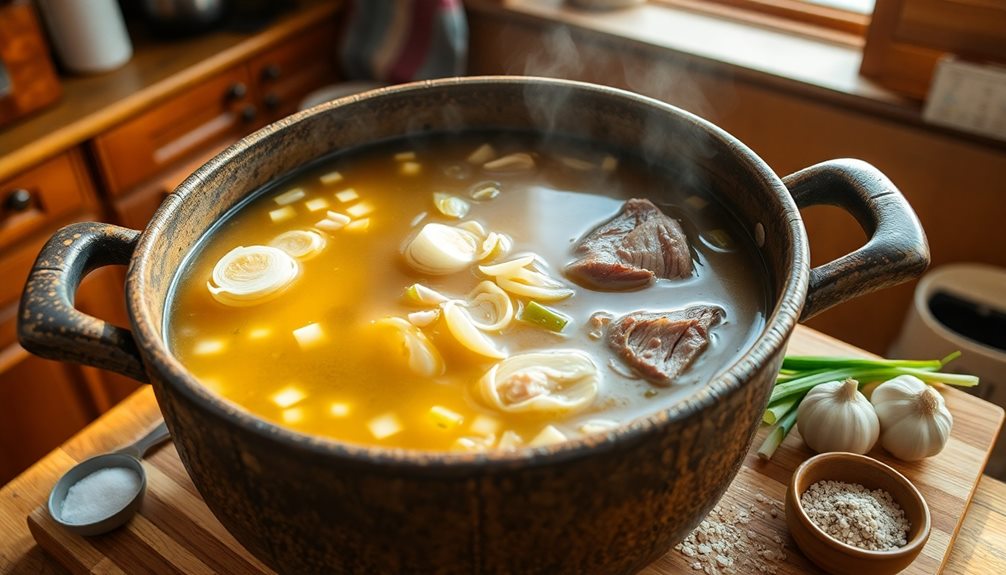
Now that you've got your rich broth ready, it's time to elevate the flavor by adding aromatics and seasonings. Start by finely chopping some garlic and ginger. These two ingredients pack a punch, giving your soup warmth and depth. Toss them into the pot and let them cook for a few minutes until they become fragrant.
Next, add sliced onions and a couple of green onions, chopped into small pieces. The onions add sweetness, while the green onions bring a fresh flavor.
Don't forget to sprinkle in some salt and pepper to taste; they're essential for bringing everything together.
For an extra kick, consider adding a splash of soy sauce or a little sesame oil. These ingredients will deepen the flavor even more.
Stir everything together and let it simmer for about 10 minutes. This allows the aromatics to blend beautifully with the broth.
Final Thoughts
When you savor a bowl of Sulung Tang, you're not just enjoying a meal; you're experiencing a rich tradition that has stood the test of time. This delicious Korean ox bone soup is all about warmth, comfort, and family. Each spoonful tells a story, connecting you to generations who've gathered around the table to share this delightful dish.
The creamy, hearty broth, made from slow-cooked bones, is perfect for warming you up on a chilly day. With every bite, you can taste the love and care that goes into making it.
Whether you're at a bustling restaurant or enjoying it at home with loved ones, Sulung Tang brings everyone together.
As you finish your bowl, think about how special it's to share a meal like this. It's not just about the food; it's about the memories you create.
Frequently Asked Questions
What Are the Health Benefits of Sulung Tang?
You'll find that dishes like sulung tang can boost your immune system, promote joint health, and provide essential nutrients. Its rich collagen content supports skin elasticity, while its warmth comforts your body during colder months.
Can I Use Other Types of Meat in Sulung Tang?
You can definitely use other types of meat in sulung tang. Experiment with beef, pork, or even chicken to create a different flavor profile. Just adjust the cooking time for optimal tenderness and taste.
How Do I Store Leftover Sulung Tang?
To store leftover soup, let it cool completely, then transfer it to an airtight container. Refrigerate for up to three days or freeze for up to three months. Reheat thoroughly before enjoying again.
What Side Dishes Pair Well With Sulung Tang?
When enjoying your meal, consider pairing it with kimchi, pickled radishes, or steamed rice. These side dishes complement the rich flavors and enhance your experience, making your meal even more satisfying and delicious.
Are There Vegetarian Alternatives to Sulung Tang?
Yes, you can create vegetarian alternatives by using vegetable broth, mushrooms, and tofu. Add in hearty vegetables like daikon and carrots for depth, and season with soy sauce or miso for a rich flavor.
